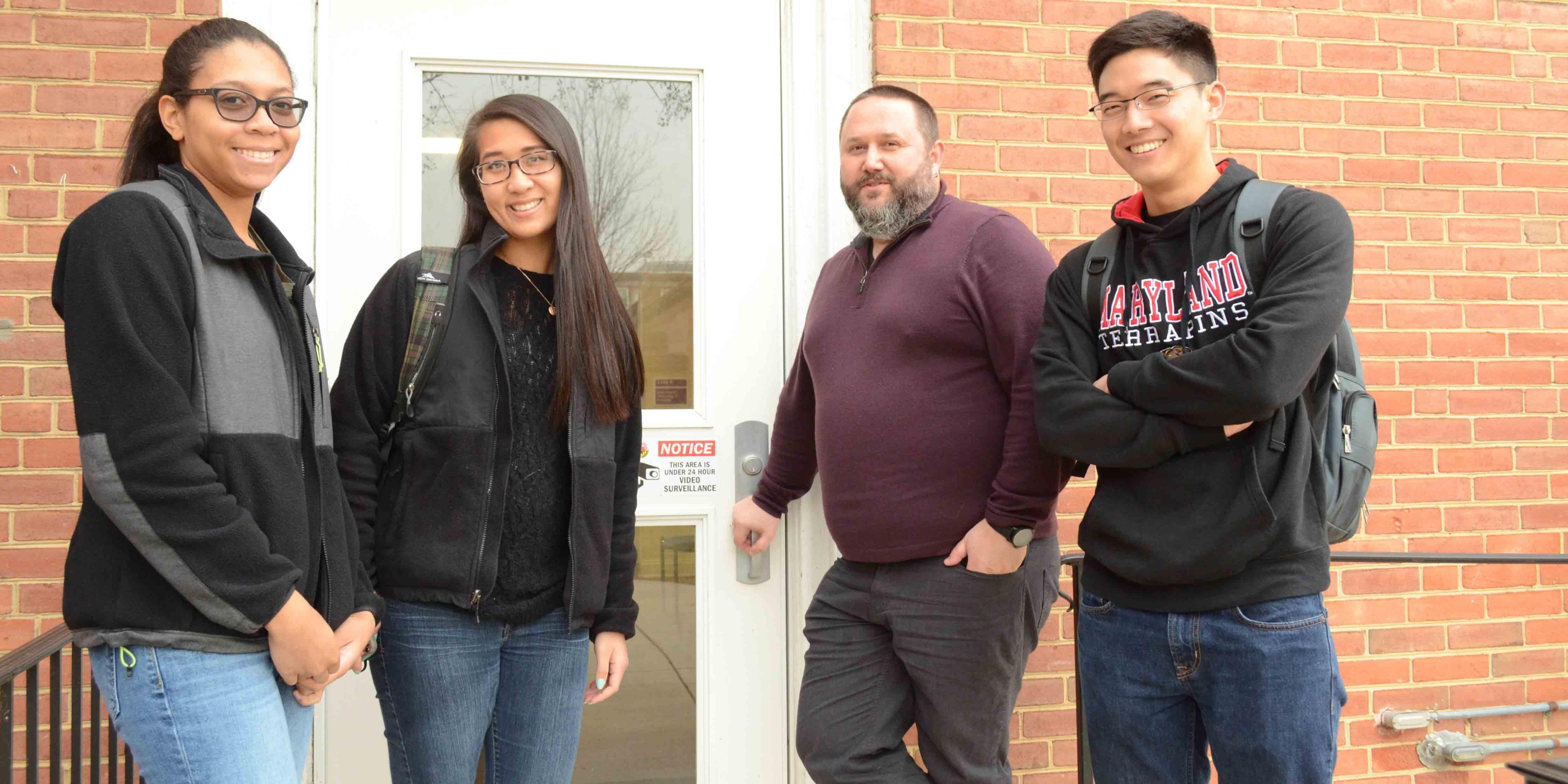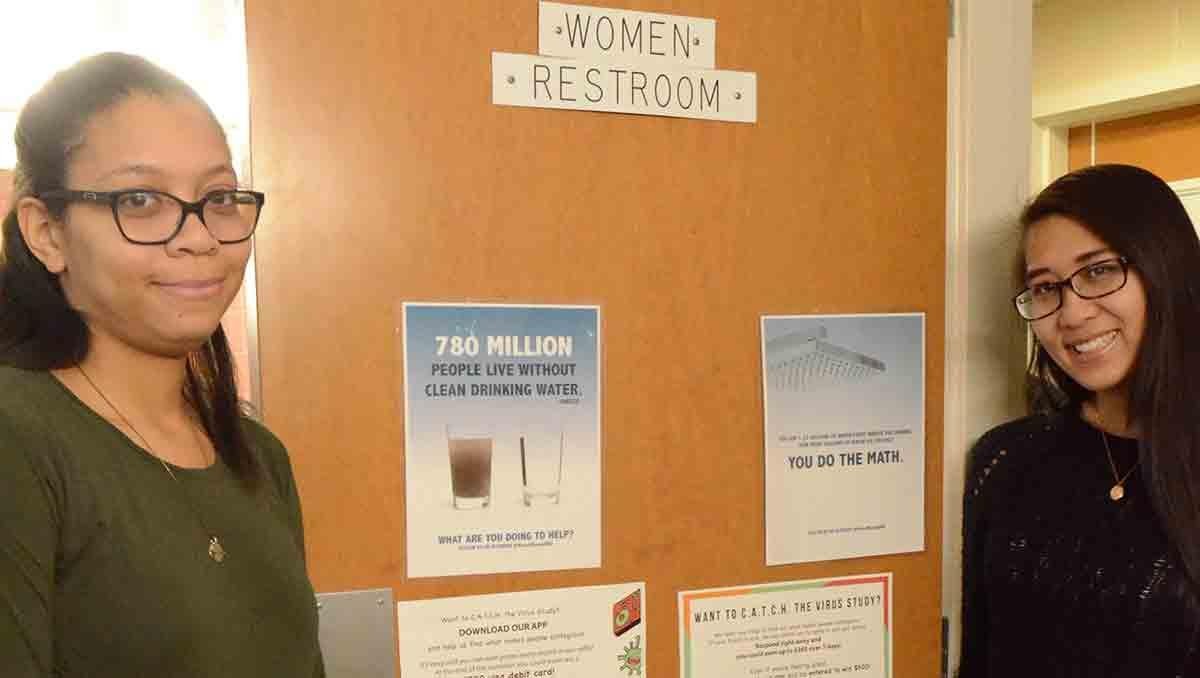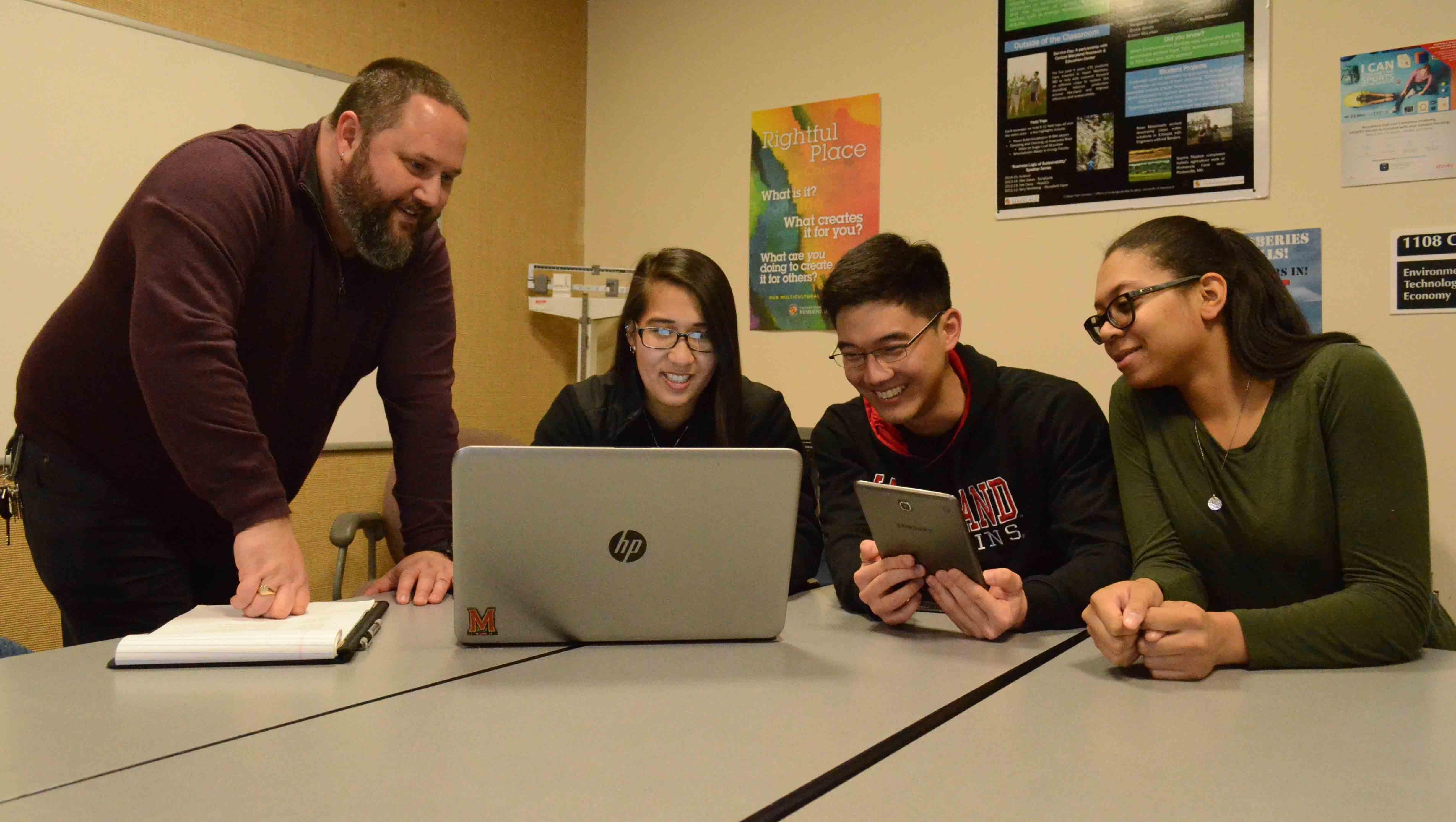
In the Environment, Technology and Economy (ETE) Scholars program, the second-semester colloquium is largely devoted to the “Connections” Project. Teams of four to six students propose an idea to enhance sustainability on campus or in the community. They research an idea, propose how best to achieve it and implement one aspect of the proposal by the end of the semester.
According to Program Director Tim Knight, “The Connections Project is one of several group projects students do in ETE, but it’s the only one where students choose their group and choose their project. We support them—we partner with the Academy for Innovation and Entrepreneurship to do some systems thinking activities and invite partners from around the university to come in and suggest project ideas—but it’s completely student driven.”
Which was how Tiffany Wun, Jada Mosley and William Ma ended up working together during the spring 2015 semester. A fellow classmate had suggested a project centered around water conservation, “and we all agreed with the idea,” says Wun.
As they note in a report, “While access to water is considered more often a concern for developing countries, this amenity is taken for granted in the United States. For an average person, it may be hard to quantify an individual’s daily water use. This is especially true for college students who use shared facilities and lack methods to track their personal water consumption.”
The five-person group wanted to target shower water usage in residence halls. The university’s Department of Residential Facilities had previously installed low-flow showerheads to reduce water consumption. Reducing shower times would be the logical next step.
The team suggested a combination of awareness raising, student education and the use of shower meters to achieve their goal; they also created an informational brochure. Their final grade on the Connections Project: an A.
From theoretical to applied research
It could have just ended there. The group members had worked “very well as a team,” according to Wun, but with the semester ending, they could have gone their separate ways to pursue their studies. (Wun is graduating this month with a degree in bioengineering, Mosley is majoring in environmental science and policy, and Ma is in computer science.)
But then–ETE Director Becky Archer encouraged the team to apply for a grant from the University of Maryland Office of Sustainability to more fully implement their Connections Project. The five students decided to go for it, also taking Archer up on her offer to supervise them through an independent study.
While the Connections Project had been largely theoretical, the grant proposal required specific research about water conservation on college campuses. The students looked into how other schools have promoted water conservation. They also connected with faculty on campus for more information and learned what the university had done previously to conserve water. Archer and Knight, who was the ETE associate director at the time, provided suggestions and contacts for the team members.
In January 2016, midway through their sophomore year, “Team Shower Power” learned they had received a $4,260 sustainability grant to pilot the project in a residence hall.
And that’s when the hard work really began.
Implementation setbacks
“It’s great that students are thinking of ways of reducing shower times,” says Mark Stewart, sustainability manager at the Office of Sustainability. “With hot water, it’s not just about water conservation but energy conservation, too. Heating 1 gallon of water to shower temperature requires the same amount of energy as running a LED light bulb for about 16 hours. A 5-minute shower, which uses about 10 gallons of water, is equivalent to keeping a light on for nearly seven days.”
But transitioning from grant writing to real-world implementation of their Shower Power project proved more than a little challenging. The team’s original plan was to install shower meters on four floors of Centreville Hall, then measure the water usage on those floors vs. the “control group” floors that did not have meters to gauge behavioral response.
Unfortunately, they couldn’t find the right shower meter for the job. The students adjusted their plans accordingly: They decided to purchase about 85 devices to be installed on all the shower heads in Centreville, allowing for better assessment data. Water usage would then be measured against usage from previous years.
The students also settled on a meter they liked—only to find that the manufacturer suddenly stopped responding to them.
“We were in good contact with the company; we had had a videoconference with them about what we were looking for. And then… nothing. It was one of our biggest setbacks,” says Mosley. “We had invested so much into this shower meter only to have it fall out [as an option]. Finding one to replace it took such a long time.”
Meanwhile, the realities of college life impeded. One teammate moved away to Hawaii. Another started a time-consuming internship that prevented him from staying involved in the project.
Making do
It took the remaining team members—Wun, Mosley and Ma—about a year to find a shower meter to serve their purposes. The device they settled on wasn’t ideal, but they made do. Says Ma: “We wanted a shower meter that would be convenient to use, but the best option was one that had 13 buttons.”
Wun adds, “It was more about timing and what we could get our hands on, plus the price range. We didn’t want to spend $50 on a shower meter for an experimental process.” (The meter they settled on cost $24.99 each.)
Working with the Department of Residential Facilities and the Department of Resident Life, the trio installed the devices in August 2017.
“We assisted the team in working through the logistics, feasibility and potential challenges,” says Tim Wheeler, senior manager of facilities maintenance for the Department of Residential Facilities. “These included how best to secure the meter and ensure it could not be easily removed [by residents] while not making it a permanent installation—all in a challenging wet environment.”
By this point, it was the start of the students’ fourth year on campus. It had been two and a half years since they had first gotten together to work on their Connections Project. It was more than 18 months after they had received their grant from the Office of Sustainability.
The meter featured a timer that students could set to count down over 10 minutes or 15 minutes. “The water conservation is up to the user. Instead of daydreaming in the shower, they can time themselves and be more aware of how long they’ve been in the shower,” Mosley explains.
Because showers could be used without the timer being turned on, Wun, Mosley and Ma did a variety of promotions to encourage meter use. They developed informational posters showing students how to use the meters, which they posted next to shower stalls. Additional posters that promoted water conservation were hung on all the bathroom doors in Centreville.
‘Big part of what Scholars is’
Now, Wun, Mosley and Ma are finally winding down with Team Shower Power.
The team recently received Centreville Hall water consumption data from the Department of Residential Facilities. They compared water consumption from August through December 2017 against water usage for the same time period from the previous eight years. Results unfortunately proved inconclusive: When including data from the months of August and December, “there was a significant [statistical] difference between the previous and current water consumption values for each month,” the team reports. Changing the parameters, however—comparing only the September through November timeframes because students are not in the residence halls for the entirety of either August or December—resulted in no significant differences.
Despite this, the trio appears to have no regrets. While acknowledging that the project was “more prolonged than we’d expected,” Wun says it nevertheless provided valuable information for all on campus.
“We as a team wanted to provide information for college students to make more educated choices in their shower usage. It’s another sustainable aspect to their lives,” Mosley says.
Ma adds: “It’s an optional thing, like the bottle stations on campus or composting. This can be among the options provided to students to make more sustainable choices.”
Knight is more emphatic about the findings from, and value of, Team Shower Power’s work.
“The statistics are inconclusive, but that’s in part because we don’t have repeated measures—we didn’t do this over several years,” he says. “But if you look at their findings, it’s clear that when they added the shower meters, there was less shower consumption than the mean for that building as compared to the previous years. That strongly suggests to me that if we did conduct this pilot for several more years, then we’d have a statistically significant correlation.”
He adds, “One goal of the pilot was to find out if this idea works, and we have a suggestion of that. But the other point I’d make is the project’s educational aspect. Tiffany, Jada and Will spent three, four years working on this project and persevered through pretty extreme situations where most students would have given up. From a student outcome perspective, it was extremely successful. And that’s a big part of what Scholars is: experiential learning.”
Indeed, when asked what lessons they’ve learned, the three are quick to answer.
“Always have a Plan B,” Ma grins.
“Things really don’t go as planned,” Wun adds.
Says Mosley, “You have to work on your feet and have good team dynamics, too.”
And it all began with that student-driven Connections Project three years ago.


